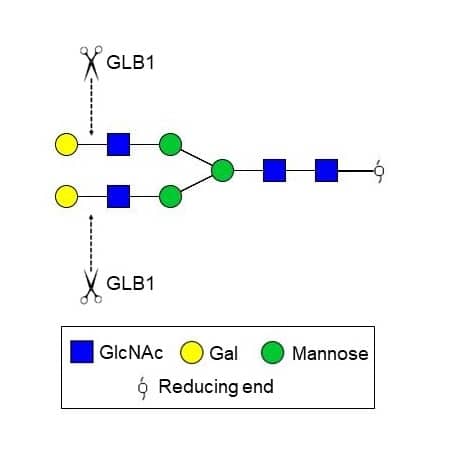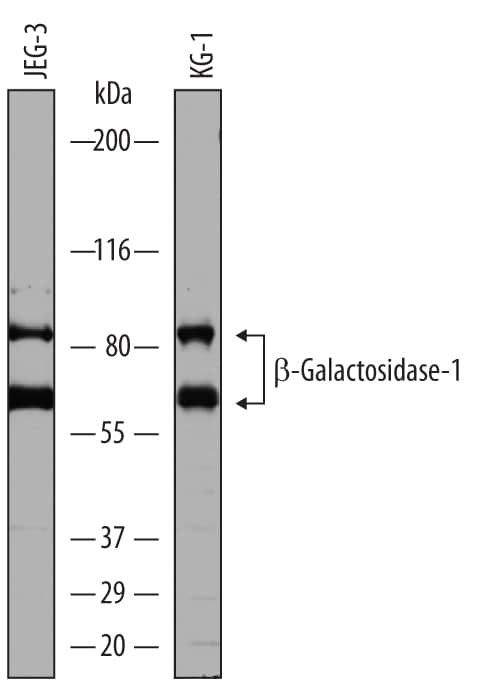beta-Galactosidase-1/GLB1 Products
beta-Galactosidase-1 (GLB1) is a lysosomal beta-galactosidase that hydrolyzes the terminal beta-galactose from ganglioside and keratan sulfate. Defects in this gene are the causes of lysosomal storage diseases for GM1-gangliosidosis and Morquio B syndrome (also known as mucopolysaccharidosis IVB). In GM1 gangliosidosis, GM1 ganglioside accumulates in the neurons of the central nervous system, because of the deficiency (0 plus or minus 3% of normal) of lysosomal beta-galactosidase activity. GM1 gangliosidosis demonstrates varying degrees of clinical severity but is invariably fatal, and children with the most common and severe form of GM1 gangliosidosis usually die within 3 years of birth. Morquio B syndrome patients are neurologically normal, but display severe skeletal dysostosis multiplex because of an accumulation of keratan sulfate. More than 100 mutations have been identified for GLB1, which result in different residual activities of the mutant enzymes and a spectrum of symptoms in the two related diseases. In lysosome, the mature beta-galactosidase protein associates with cathepsin A and neuraminidase 1 to form the lysosomal multienzyme complex. An alternative splicing at the RNA level of GLB1 results a catalytically inactive beta-galactosidase (also called elastin-binding protein) that plays an important role in vascular development.
37 results for "beta-Galactosidase-1/GLB1" in Products
37 results for "beta-Galactosidase-1/GLB1" in Products
beta-Galactosidase-1/GLB1 Products
beta-Galactosidase-1 (GLB1) is a lysosomal beta-galactosidase that hydrolyzes the terminal beta-galactose from ganglioside and keratan sulfate. Defects in this gene are the causes of lysosomal storage diseases for GM1-gangliosidosis and Morquio B syndrome (also known as mucopolysaccharidosis IVB). In GM1 gangliosidosis, GM1 ganglioside accumulates in the neurons of the central nervous system, because of the deficiency (0 plus or minus 3% of normal) of lysosomal beta-galactosidase activity. GM1 gangliosidosis demonstrates varying degrees of clinical severity but is invariably fatal, and children with the most common and severe form of GM1 gangliosidosis usually die within 3 years of birth. Morquio B syndrome patients are neurologically normal, but display severe skeletal dysostosis multiplex because of an accumulation of keratan sulfate. More than 100 mutations have been identified for GLB1, which result in different residual activities of the mutant enzymes and a spectrum of symptoms in the two related diseases. In lysosome, the mature beta-galactosidase protein associates with cathepsin A and neuraminidase 1 to form the lysosomal multienzyme complex. An alternative splicing at the RNA level of GLB1 results a catalytically inactive beta-galactosidase (also called elastin-binding protein) that plays an important role in vascular development.
| Source: | CHO |
| Accession #: | AAA51819 |
| Applications: | EnzAct |
| Reactivity: | Human, Mouse, Canine, Monkey, Non-species specific |
| Details: | Mouse IgG2A Monoclonal Clone #OTI1C9 |
| Applications: | IHC, WB, ICC/IF |
| Reactivity: | Human |
| Details: | Mouse IgG2a Monoclonal Clone #810226 |
| Applications: | WB |
| Reactivity: | Human |
| Details: | Sheep IgG Polyclonal |
| Applications: | WB, Simple Western |
Recombinant Monoclonal Antibody
| Reactivity: | Human, Mouse, Rat |
| Details: | Rabbit IgG Monoclonal Clone #JE40-77 |
| Applications: | WB, Flow |
| Reactivity: | Human |
| Details: | Rabbit IgG Polyclonal |
| Applications: | IHC |
| Reactivity: | Human |
| Details: | Mouse IgG2a Kappa Monoclonal Clone #6E7 |
| Applications: | WB, ELISA, IP |
| Applications: | AC |
| Reactivity: | Human, Rat |
| Details: | Rabbit IgG Polyclonal |
| Applications: | IHC, WB, ICC/IF |
| Reactivity: | Mouse, Rat |
| Details: | Rabbit IgG Polyclonal |
| Applications: | WB |
| Applications: | AC |
| Applications: | ELISA |
| Applications: | WB |
| Reactivity: | Human, Canine, Monkey |
| Details: | Mouse IgG2A Monoclonal Clone #OTI1C9 |
| Applications: | IHC, WB |
| Reactivity: | Human, Canine, Monkey |
| Details: | Mouse IgG2A Monoclonal Clone #OTI1C9 |
| Applications: | IHC |
| Reactivity: | Human, Canine, Monkey |
| Details: | Mouse IgG2A Monoclonal Clone #OTI1C9 |
| Applications: | IHC |
| Reactivity: | Human, Canine, Monkey |
| Details: | Mouse IgG2A Monoclonal Clone #OTI1C9 |
| Applications: | IHC |
| Reactivity: | Human, Canine, Monkey |
| Details: | Mouse IgG2A Monoclonal Clone #OTI1C9 |
| Applications: | IHC, WB |
| Reactivity: | Human, Canine, Monkey |
| Details: | Mouse IgG2A Monoclonal Clone #OTI1C9 |
| Applications: | IHC |
| Reactivity: | Human, Canine, Monkey |
| Details: | Mouse IgG2A Monoclonal Clone #OTI1C9 |
| Applications: | IHC |
| Reactivity: | Human, Canine, Monkey |
| Details: | Mouse IgG2A Monoclonal Clone #OTI1C9 |
| Applications: | IHC |
| Reactivity: | Human, Canine, Monkey |
| Details: | Mouse IgG2A Monoclonal Clone #OTI1C9 |
| Applications: | IHC |
| Reactivity: | Human, Canine, Monkey |
| Details: | Mouse IgG2A Monoclonal Clone #OTI1C9 |
| Applications: | IHC |
| Reactivity: | Human, Canine, Monkey |
| Details: | Mouse IgG2A Monoclonal Clone #OTI1C9 |
| Applications: | IHC |
| Reactivity: | Human, Canine, Monkey |
| Details: | Mouse IgG2A Monoclonal Clone #OTI1C9 |
| Applications: | IHC |



![Western Blot: beta-Galactosidase-1/GLB1 Antibody (OTI1C9) [NBP2-45731] Western Blot: beta-Galactosidase-1/GLB1 Antibody (OTI1C9) [NBP2-45731]](https://resources.bio-techne.com/images/products/beta-Galactosidase-1-GLB1-Antibody-1C9-Western-Blot-NBP2-45731-img0016.jpg)


![Western Blot: beta-Galactosidase-1/GLB1 Antibody (JE40-77) [NBP3-32383] beta-Galactosidase-1/GLB1 Antibody (JE40-77)](https://resources.bio-techne.com/images/products/nbp3-32383_rabbit-beta-galactosidase-1-glb1-mab-je40-77-27820241631685.jpg)
![Immunohistochemistry-Paraffin: beta-Galactosidase-1/GLB1 Antibody [NBP2-49602] Immunohistochemistry-Paraffin: beta-Galactosidase-1/GLB1 Antibody [NBP2-49602]](https://resources.bio-techne.com/images/products/beta-Galactosidase-1-GLB1-Antibody-Immunohistochemistry-Paraffin-NBP2-49602-img0006.jpg)
![Western Blot: beta-Galactosidase-1/GLB1 Antibody (6E7) [H00002720-M01] Western Blot: beta-Galactosidase-1/GLB1 Antibody (6E7) [H00002720-M01]](https://resources.bio-techne.com/images/products/beta-Galactosidase-1-GLB1-Antibody-6E7-Western-Blot-H00002720-M01-img0005.jpg)
![Western Blot: beta-Galactosidase-1/GLB1 Antibody [NBP1-32018] Western Blot: beta-Galactosidase-1/GLB1 Antibody [NBP1-32018]](https://resources.bio-techne.com/images/products/beta-Galactosidase-1-GLB1-Antibody-Western-Blot-NBP1-32018-img0006.jpg)
![Western Blot: beta-Galactosidase-1/GLB1 Antibody [NBP3-13394] Western Blot: beta-Galactosidase-1/GLB1 Antibody [NBP3-13394]](https://resources.bio-techne.com/images/products/beta-Galactosidase-1-GLB1-Antibody-Western-Blot-NBP3-13394-img0001.jpg)
![ELISA: Rat beta-Galactosidase-1/GLB1 ELISA Kit (Colorimetric) [NBP2-82182] - Rat beta-Galactosidase-1/GLB1 ELISA Kit (Colorimetric)](https://resources.bio-techne.com/images/products/nbp2-82182_rat-beta-galactosidase-1-glb1-elisa-kit-colorimetric-132202416102223.jpg)
![Western Blot: beta-Galactosidase-1/GLB1 Overexpression Lysate [NBL1-11106] Western Blot: beta-Galactosidase-1/GLB1 Overexpression Lysate [NBL1-11106]](https://resources.bio-techne.com/images/products/GLB1-Overexpression-Lysate-Adult-Normal-Western-Blot-NBL1-11106-img0002.jpg)
